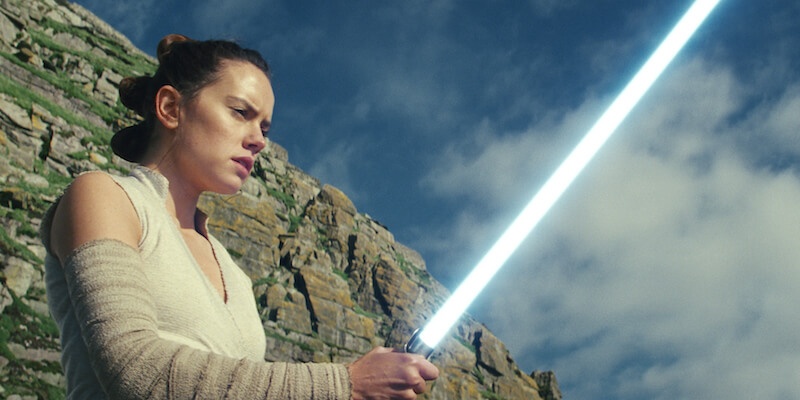Find out how the sound team from Star Wars: The Last Jedi approached and built the film's stellar sound – from vocal processing to Rey's mirror world.
For sound designer Ren Klyce, Star Wars: The Last Jedi was a dream come true. It was his first professional foray into the Star Wars universe. Klyce co-supervised the sound alongside Matthew Wood — who’s practically a Jedi Master of Star Wars sound, having spent the last twenty years working on Star Wars films, animated series, and games.
Working with their team at Skywalker Sound in Marin County, CA, Wood and Klyce created fresh, new sounds for The Last Jedi by looking to the past for inspiration, techniques and sound sources used by the original Star Wars sound designer Ben Burtt. They expanded on the Star Wars universe without straying too far from its roots.
Wood and Klyce share details on how they approached the vocal processing, lightsaber battles, and that mega light-speed ship explosion. They also discuss director Rian Johnson’s intentional use of silence which was key to selling several impactful moments in the soundtrack.
Warning: Contains spoilers.
Images from film courtesy of Walt Disney Studios Motion Pictures / Lucasfilm Ltd. / Industrial Light & MagicThis is director Rian Johnson's first Star Wars film. What did he want to contribute to the Star Wars universe sound-wise? What were his goals for sound on this film?
Matthew Wood: It’s always so exciting for us when new directors come on board. They bring their unique vision to the film and to Star Wars. This film is such a stepping off point for the new trilogy. We’ve established already who the characters are and where we are going but this film has the new director’s vision all over it. He has such a love for Star Wars — for what has come before and a drive to push us forward. A TIE fighter is going to sound like a TIE fighter and a lightsaber is going to sound like a lightsaber. Those sounds are going to be familiar, but it’s our job to update them and to come up with new sounds for the environments, creatures, vehicles and weapons. The excitement that Rian and Ren (who are both working on Star Wars for the first time) have is infectious.
Ren Klyce: Matt has worked on all of the Star Wars films for many years now and he knows them so well. But for someone like myself, it’s all a new landscape. I certainly grew up with Star Wars and knew it as a fan, but being able to come into Rian’s world and the Star Wars universe is incredibly exciting. I think it’s every young person’s dream – any fan with a love for John Williams’ music and the sound design of Star Wars. It’s a dream come true to be honest.
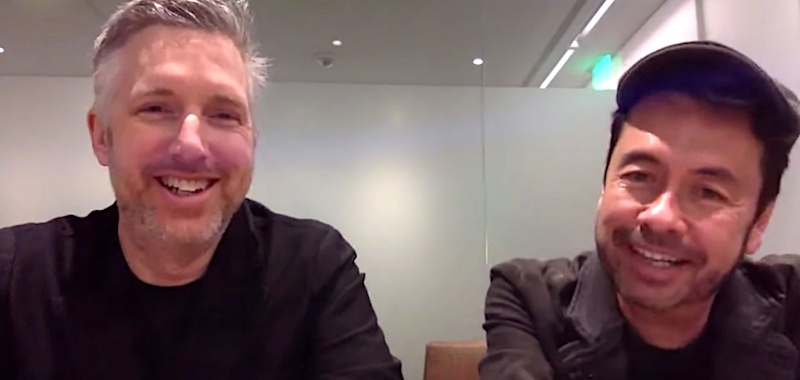 Matthew Wood & Ren Klyce (Photo credit: Gold Derby)
Matthew Wood & Ren Klyce (Photo credit: Gold Derby)Klyce: The first thing that Matt and I did was read the script. Then we flew over to meet Rian and Ram [Bergman, producer] and they were really nice. They invited us to meet everyone early on and get a sense of the film as it was being made. That was really helpful to inform the sound.
As we were reading the screenplay, we noticed striking things that rose to the top of our list — namely, the force connection moments between Kylo Ren and Rey as they speak across space and time, and the mirror cave scene wherein Rey is searching for her parents/the truth of her origin. What were those going to sound like? We were able to ask Rian in our early conversations about everything that was new for us, like the creatures: the Porgs, the Fathiers… what were those going to sound like? Those were the initial conversations that we had.
What was great about working with Rian was that he didn’t describe sound effects in clinical terms, like, “I want to hear a high-frequency tingly sound that should go swooping down into the low frequencies.” He didn’t speak in terms of timbre or that sort of thing, which is okay to do. There’s nothing wrong with that. Rian took a different approach, though. He spoke more in terms of what he wanted to feel emotionally. It is quite fun for us to get those kinds of directions that allowed us to get into his psyche — what is it he’s trying to make the audience feel.
“[Rian] didn’t describe sound effects in clinical terms…He spoke more in terms of what he wanted to feel emotionally.”
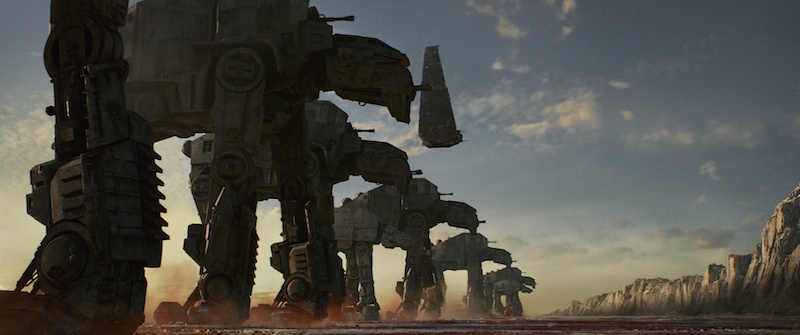
You mentioned Kylo Ren and Rey talking to each other across space via the force. Can you share your approach to the sound for that? Also, what audio tools helped you to achieve that vocal processing?
Klyce: What was interesting about that scene was reading it first, and then seeing it. The way that Rian created it visually was not what Matt and I had originally expected. When we read it we were thinking that there was going to be a visual effect, like they would be glowing, or like in The Lord of the Rings where they put on the ring and suddenly the world is scintillating with visual effects. We thought that there would be visuals that would inform us that they’re speaking across the galaxy. But when we saw it, it was way different than that. It was very bold-style filmmaking on Rian’s part to do it with just editing and vertical cuts. It was very Kurosawa, very old school, which is a beautiful way to construct it visually. We realized that it would call upon the sound more to relay that these two people were somehow connecting with each other.
One of the ideas that we had was to hear Kylo Ren’s voice before he spoke, as if it was traveling through the galaxy towards Rey and at last arriving and we hear it (as the audience) with her. We experimented with a lot of different plug-ins. We used a technique of reversal where we took a line of his dialogue, or a line of her dialogue, and reversed it. Then we added reverb and delay effects to their dialogue. Then reversed that processed dialogue again and edited that ahead of the sound. So you hear a pre-lap, if you will. We used Audio Ease’s Altiverb and some Soundtoys delay plug-ins. We used some stock Pro Tools plug-ins too. We layered those sounds and off-set them against each other to create that texture. Then lastly, using the Atmos surround field, we panned the sounds around the theater and that helped a lot as well because you hear the sound not only approaching you but moving around the movie theater. It’s moving around the audience’s head and hopefully giving a sense that something is coming towards them. So that was the starting point for that technique.
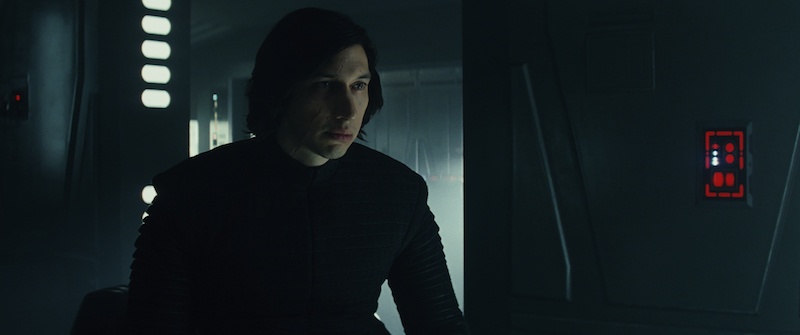 Kylo Ren (Adam Driver)
Kylo Ren (Adam Driver)One of the scenes we had to loop was with Daisy Ridley (who plays Rey) because there was a lot of water and rain activity behind her in the shots. She was able to nail those performances. She’s an expert looper. Looping her lines really helped us with stripping everything away and making it really quiet. In some of those scenes, you hear Kylo Ren turn around and it’s just one little footstep and a breath and then they go into this communication method and it’s really intimate. It was about stripping back the sounds around that. The producer was worried about being that quiet but I feel like it was very effective for those moments, to help the audience hone-in on their communication.
Klyce: Getting back to how Rian would communicate what he wanted, he said, “I want it to feel like a vacuum.” Similar to an email or a text, you can interpret those words in a number of different ways. A vacuum might have a sound like a rumble, or the feeling of being underwater, or muted. But ultimately, the vacuum literally meant ‘nothing’ in this and many instances. That was a fun thing to discover with Rian and our whole team while we were mixing. Creating the silence all together was a wonderful moment of collaboration.
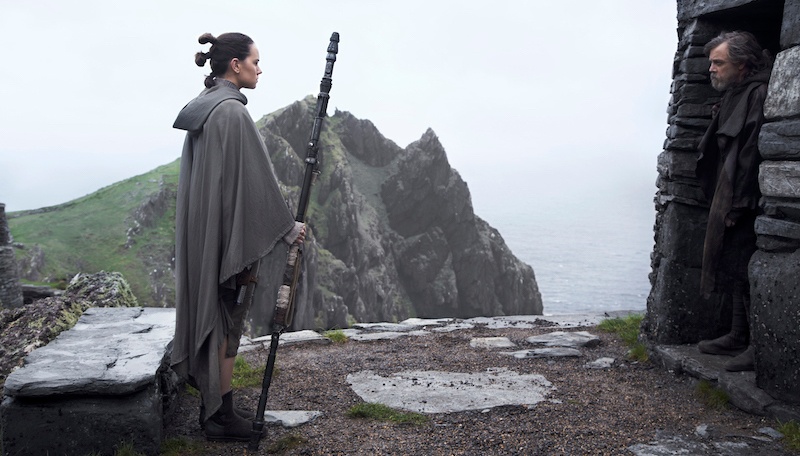 Rey (Daisy Ridley) & Luke Skywalker (Mark Hamill)
Rey (Daisy Ridley) & Luke Skywalker (Mark Hamill)Another interesting scene on Jedi island, Ahch-To, was when Rey interacts with her reflection on the cave wall. That was such a cool scene for sound. How did you create that scene?
Klyce: The mirror cave scene was one that we were most excited about when reading the script initially. It felt metaphysical and spiritual.
Rian really wanted to have that vertical delineation from the moment that Rey crawls out of the water and approaches the mirror cave. The moment that Rey touches the mirror, we cut and are on the other side of the glass (so to speak) and that’s where the adventure starts. Rian made it clear that the touch was the kicking-off point. Right on that cut, the entire soundtrack that we were creating would change vertically.
A lot of the sounds in that scene were natural ones, like recordings captured underwater, the sound of ocean kelp and ice — very strange yet organic sounds that were then manipulated via a sampler using Native Instruments Kontakt. We created a palette of sounds for the mirror world.
When she snaps her finger, the snap sound was done editorially with just a finger snap that we lined up to picture. We panned it, moved it, and reverbed it. We used a technique that was similar, in a way, to what we did on the force-connection dialogue.
We actually had more sounds in that scene that Rian took out at the last second. Rey clenches her fist and there was a repeating sound for that which we had moving around the surrounds. We ended up getting rid of a few things per Rian’s request, just to open it up. But there are lots of different textures in there.
There’s the buildup of her lines, her dialogue, when we hear her plea to the mirror. She says, “Let me see them, my parents.” And the idea was to hear 1,000 of her saying, “Let me see them, let me see them…” and then arriving at the one from the Rey that we are with. That was quite fun to craft as well.
Lastly, there’s John Williams’ music. He created this beautiful piece which is a little bit outside of the realm of traditional Star Wars score in that it’s more textural.
The combination of the music, dialogue, and sound effects in the cave was really fun to craft and took a long time. We went back and forth with Bob Ducsay (picture editor). We would send tracks and they would cut the picture using some of our sounds. They’d send it back to us and we could hear that they liked this or didn’t like that. It was a great method of collaboration during the editorial process. That section took time to craft, but in a good, long steady way that allowed us to discover the scene.
“We created a palette of sounds for the mirror world. A lot of the sounds in that scene were natural ones, like recordings captured underwater, the sound of ocean kelp and ice — very strange yet organic sounds.”
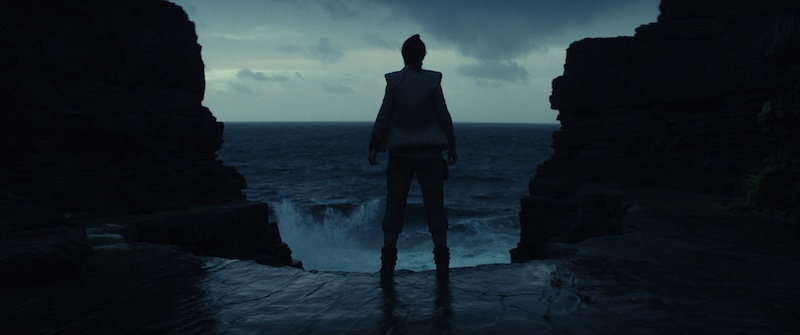
There are more fun sounds on that island. Rey hears voices on the wind that lead her to a misty cavern that houses the ancient Jedi tomes. Can you talk about your approach to the sound on that sequence?
Wood: Ren and I would occasionally go down to the editorial suite to meet with Bob [Ducsay] and Rian. There was an idea to have something pull Rey’s focus that way toward the tree. We had some tonal sounds and some creepy sounds, and then there was the idea to try something like a chant of some sort, or some kind of voices. That’s when everything came together there. We have a story group at Lucasfilm that tracks everything that we’re doing story-wise, for all the films and TV shows and all that for Star Wars. A couple members of the story group — Leland Chee and Pablo Hidalgo, pulled something from an old Star Wars publication that has something called the Jedi code in it. It was a chant about what it means to be a Jedi. So for loop group, we all came together and chanted this as a whispery version and as a more low-chant version. We wanted to make that the base of the sound. Then Ren took that and really tweaked it out and it culminates right when Luke says something like, “Who are you?” And there was also reverse reverb on that line.
Klyce: It was a similar technique to that of Kylo Ren and Rey’s force-connect communication. We did a lot with taking the raw sounds and flipping them around backwards, adding reverb and delay, then reversing that to create a base-line, consistent with the ethereal aspects of the dialogue.
The interesting thing was that it took us a while to arrive at that because there were quite a number of iterations prior to Rian’s idea of the Jedi scripture. We had animal sounds at one point; we had scraped metal and rubbed glass sounds that were the sound of the tree. There was one version where it was a woodpecker pecking a tree slowed down. There is a bit of that still in there actually, and it’s part of the sound that calls her.
We went through many different passes to figure out what it was. There was also John Williams’ score in there as well. We ended up getting rid of the music and just focusing on the audio of these voices. That was another wonderful thing to arrive at, but which took a lot of experimentation.
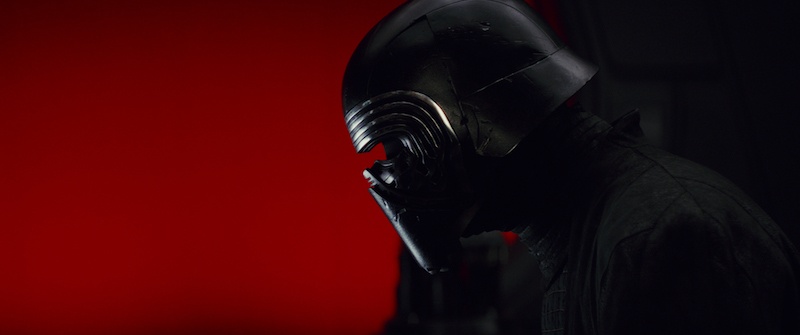
There’s so much interesting vocal processing in this film. Another one that caught my ear was the voice of Snoke's hologram when he first appears on the bridge of Hux's ship. Can you talk about Snoke's vocals there?
Wood: We hadn’t seen Snoke physically in person yet at this point, and so we continue with this giant version of him that we saw in The Force Awakens. We wanted his voice to fill up the room so we had all speakers coming at you. There is heavy surround use there. So that was connected to The Force Awakens version.
Klyce: Later we meet Snoke as a man, but before that, he’s this gigantic hologram, forty or fifty feet tall, and you get this notion of “pay no attention to the man behind the curtain,” Wizard of Oz kind of scaling of sound on his dialogue. So on that first shot of Snoke’s hologram in The Last Jedi, we used some bass enhancement plug-ins like Lowender (by reFuse) and LoAir (by Waves). We used a low-pass filter on his dry dialogue signal and ran that through Lowender and LoAir and found a good balance of having a boomy quality without him sounding like a monster. We wanted this big bass, chest tone. To that end, we added some reverb using Altiverb. There were some great Altiverb reverb patches that we found. We layered some small space reverbs and large space reverbs on top of each other. It was a bit crazy in there — was it a big space, or a small space, or how about both?
Wood: The performance of actor Andy Serkis as Snoke was such a surprise. The first time I ever heard his Snoke voice intensely was when we did the trailer for The Force Awakens. It was incredible to hear this voice come out of this man. He’s such a talent and he’s done The Lord of the Rings movies and worked with Peter Jackson. But when we record him on the looping stage, people always do a double take to hear this voice coming out of this man’s body because it’s so resonant and so deep and commanding and he can get the character across and he doesn’t just sound like a monster. Andy Serkis is phenomenally talented.
“We were walking in the footsteps of Ben Burtt, and we wanted to make sure that we were doing things that were true to the sounds of Star Wars while also trying to reimagine it in a way that inspires us and helps us editorially for this film.”
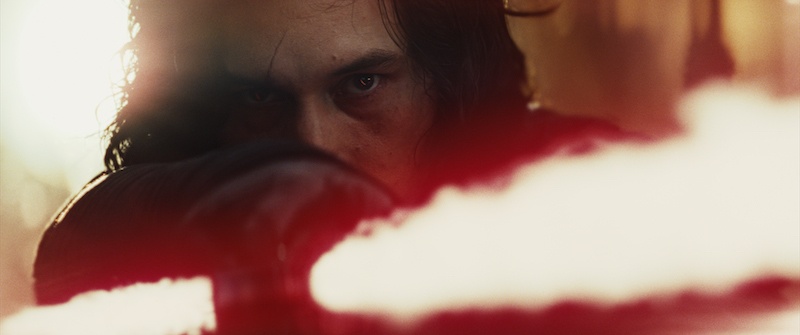 Kylo Ren (Adam Driver)
Kylo Ren (Adam Driver)We can’t talk about Star Wars and not talk about the lightsabers. Did you guys have a favorite lightsaber battle to design on The Last Jedi?
Klyce: They are all really challenging for our team. Each scene is great, I think. You have the first big scene with Rey as she’s teaching herself how to use her lightsaber. Then of course there’s the wonderful battle with Kylo Ren and Rey teaming up together. That was wonderful to watch them battle against the Praetorian Guards — those red, shiny clad protectors of Snoke. That scene is great. Also, there’s that buildup at the end of the fight as Kylo Ren and Rey are both using the force to try to get command of the lightsaber although there aren’t lightsaber sounds right there. All of those are great.
I don’t know if there’s a favorite but the most challenging for the effects editors (Bonnie Wild and Jon Borland) to edit was the Praetorian Guard fight.
There’s also that fight at the end with Kylo Ren and Luke. Even though they don’t clash their lightsabers, that was very impressionistic. In fact, we used the traditional Ben Burtt sounds throughout that scene but also Rian wanted to create this Kurosawa/otherworldly sound for some of the slow-mo shots. We used voices screaming on some of those shots. So some unusual sweeteners were added to the old sounds of the lightsabers. There’s a whole universe of sound in that lightsaber battle for sure.
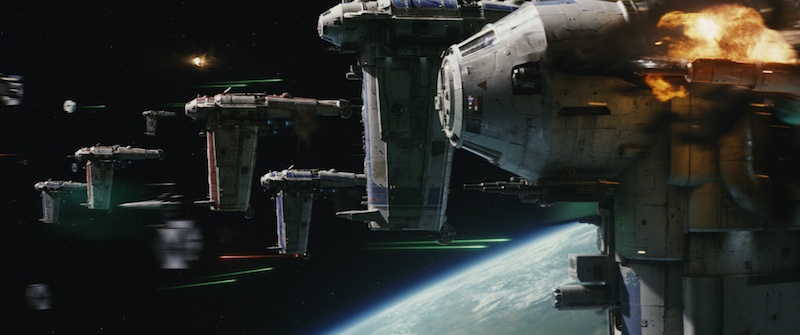
The scene when Vice Admiral Holdo points the Raddus at the First Order's Star Dreadnought and jumps to light speed causing a massive explosion – can you talk about your approach to that scene? When we do finally hear the explosion, what went into creating that sound?
Wood: That’s one of those scenes where having someone like Rian Johnson on the film — just to do something that bold with silence in that moment – was electrifying for all of us. It’s such a poignant moment in the film with Holdo’s big sacrifice and it’s a big turning point for the resistance because now they have a shot again. We hold on that silence for a long time while the visuals are unfolding in the scene.
We had a similar moment in Attack of the Clones with the sonic charges and Obi-Wan, but I never thought we would take it as far as this. It’s a huge testament to Rian Johnson to take a theatrical risk like that, to use that much silence. You have technicians in the backroom going, “It’s going to sound like an error!” In fact, some movie theaters wanted to tell the public that it was intentional that there’s no sound at that point.
Klyce: Matt’s right. Matt was in L.A. and he sent a photograph of some sign that said something like, “Dear Audience Member: At 1:47:00 minutes into the film, the film’s soundtrack will go completely silent. This is an intentional use of sound by the filmmakers. Please be aware.” It was this disclaimer that was hanging on the backs of all of the chairs in some theater somewhere. It’s actually kind of fun for us to see that as a warning label, because that much silence is so unexpected.
The funny thing is, there’s actually sound through most of it but it’s tapering off. There’s such a big buildup of music and sound before the explosion that your ears naturally think that the track went silent. But the sound does taper off and there are only 18 or 19 frames of absolute silence right before the big explosion.
Certainly the timing of that moment was a lot of fun, and that was Bob Ducsay’s genius to figure out where that moment should be. He was the one to position the timing of that explosion.
The sound of the explosion was made from all different sorts of explosions and we took a long time to get there, but the one sound that you can kind of make out in there is the sound of a race car, an Indy 500 car, zipping by and there’s Doppler on there. But then it’s been sped up, and doubled and flanged, which is a Star Wars technique that can be heard in all of the films. We were trying to lean on the techniques of old-school flanging using the old techniques of off-timing one sound slightly against the other by a few milliseconds. And then we carefully edited the Doppler on top of the explosion to create that strange, ethereal, ghost-like cry. That’s what you’re hearing.
“We were trying to lean on the techniques of old-school flanging using the old techniques of off-timing one sound slightly against the other by a few milliseconds.”
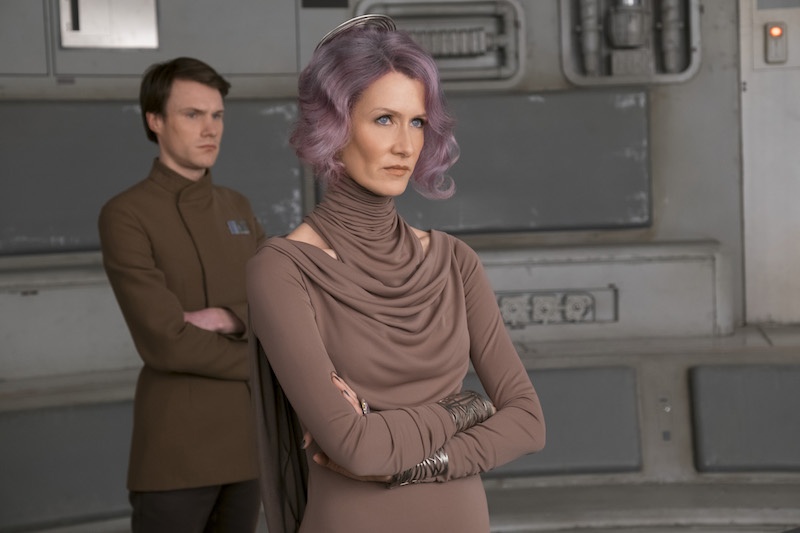 Amilyn Holdo (Laura Dern)
Amilyn Holdo (Laura Dern)Any other favorite battle scenes for sound?
Wood: I’m partial to the whole sequence in which Snoke gets killed and then we go to the Praetorian Guard fight. The way that the picture is cut there and the way the music culminates on the moment when Snoke gets cut in half is great. We do another moment of almost silence there as Rey and Kylo Ren go back-to-back. It gets really quiet before they launch into the battle. Everything is working at that point. You have the music cranking really well and all the fight sounds done in ADR by Adam Driver and Daisy Ridley. All the Foley there is really wonderful and the sound design that Ren has put in. That’s where the mix really came together well too. There’s such a peak there at that moment when Rey catches the lightsaber after it cuts through Snoke. That for me is a great scene and I’ll always get goosebumps there.
Did you capture any field recordings for The Last Jedi? How did those sounds become incorporated into the design?
Klyce: We did a lot of recordings. We used the Sound Devices 422 using a Neumann KMR 81 mic for a lot of the sounds that went into creating the impacts and metallic sounds that were used all throughout the Kylo Ren/First Order world, whether we're on a ship or where ever. A lot of the sounds we recorded at a metal shop. We were recording at 192k and used an array of mics including the KMR 81, Sennheiser 416, and a few others.
We took those recordings that we captured at a high sample rate and slowed them down and we were able to retain the high-frequency information thanks to the high sample rate of the recordings. You get a wonderful sense of deep or slow sounds yet they don’t feel like they were pitched or slowed down.
We did a lot of recording here at Skywalker Ranch on the scoring stage. It’s a beautiful room originally designed for recording orchestra and it has these wonderfully designed baffles on the sides that can slide out like 60 feet. You can make the room sound quite intimate or you can open up the room and the ceiling too and reveal the hard surfaces. I think the reverb time is 3.6 seconds. So that’s 3 ½ seconds of natural reverb in this beautiful church-like room that George Lucas built.
We got to record a lot of different sounds in this room from the casino and the coins. When we reimagined the lightsabers we recorded them on this scoring stage. When we recorded sounds for Rey turning on the lightsaber (before her practice where she’s teaching herself how to use it), we used a life vest, which was originally Ben Burtt’s idea. We figured out that that’s what he used. And so we found our own life vest that was powered by CO2 cartridges and all of us got together and ripped open these life vests. We were able to use new equipment and new microphones and high sample rates to get these beautiful, high-resolution, high-definition recordings. We were walking in the footsteps of Ben Burtt, and we wanted to make sure that we were doing things that were true to the sounds of Star Wars while also trying to reimagine it in a way that inspires us and helps us editorially for this film.
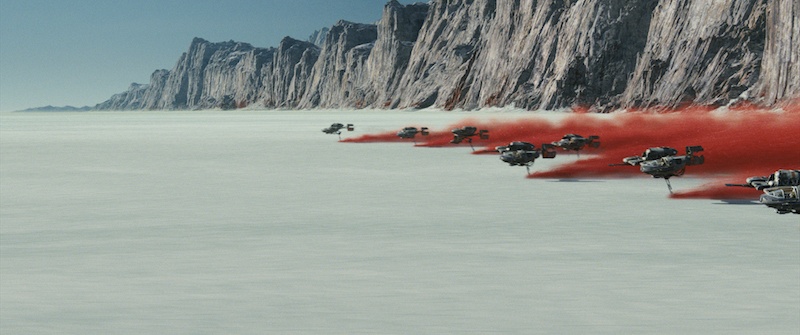
If there’s one thing that you’d want other sound pros to know about your work on The Last Jedi, what would it be?
Klyce: We were very fortunate that we were allowed the time to build and mix the sounds. If anything, I’d want to share how important it is to have the time from production to allow us to do the sound. That was so helpful. People say, “Wow, you did such a great job,” but I feel like anyone could do this work if they were allowed the time to experiment and if they’re given the freedom to mix, pre-mix and pan every little piece of Foley and to add just the right amount of reverb and so forth. A lot of films suffer from the fact that they don’t have the time, and we were lucky that we did.
Follow Skywalker Sound: skysound.com
Follow Jennifer Walden: @AudioJeney



